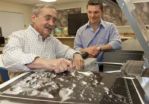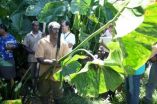Risk gene for severe heart disease discovered
2010-10-22
(Press-News.org) Research led by Klaus Stark and Christian Hengstenberg of the University of Regensburg identified a common variant of the cardiovascular heat shock protein gene, HSPB7, which was found to increase risk for dilated cardiomyopathy by almost 50%. Their paper appears on October 28 in the open-access journal PLoS Genetics.
Per year, about 6 in 100,000 individuals develop dilated cardiomyopathy (DCM), with a higher prevalence in men. This disease is characterized by an enlarged, weakened heart, subsequently affecting the pumping capacity and often leading to chronic heart failure.
Those cases of DCM that occur in certain family groups are associated with a number of mutations affecting muscle cells. However, most cases are of unknown cause. To identify risk alleles for non-familial forms of DCM, an international collaboration of scientists analyzed the contribution of common gene variants to the more frequent, sporadic form of dilated cardiomyopathy, by conducting a large-scale genetic association study with more than 5,500 subjects. Different study groups from Germany and France contributed both well-characterized DCM patients and healthy controls. The HSPB7 gene was strongly associated with susceptibility to DCM.
The researchers concluded that, while genetic testing for this variant is not suitable to date, the findings are a first step towards supporting future preventive measures for this severe form of heart muscle disease.
INFORMATION:
FINANCIAL DISCLOSURE: Part of this work was financed by the German National Genome Research Network (NGFN-2 01GS0417 and NGFNplus Atherogenomics 01GS0832) and by the University Hospital of Regensburg, Germany. Part of this work was supported by grants from Assistance Publique - Hopitaux de Paris [PHRC: AOM04141], the Fondation LEDUCQ (Eurogene Heart Failure network and CAERUS network), the Societe Francaise de Cardiologie/Federation Francaise de Cardiologie (grant in 2006). The KORA research platform (KORA, Cooperative Research in the Region of Augsburg) was initiated and financed by the Helmholtz Center Munich - German Research Center for Environmental Health, which is funded by the German Federal Ministry of Education and Research (BMBF) and by the State of Bavaria. The funders had no role in study design, data collection and analysis, decision to publish, or preparation of the manuscript.
COMPETING INTERESTS: The authors have declared that no competing interests exist.
CITATION: Stark K, Esslinger UB, Reinhard W, Petrov G, Winkler T, et al. (2010) Genetic Association Study Identifies HSPB7 as a Risk Gene for Idiopathic Dilated Cardiomyopathy. PLoS Genet 6(10): e1001167. doi:10.1371/journal.pgen.1001167
PLEASE ADD THIS LINK TO THE FREELY AVAILABLE ARTICLE IN ONLINE VERSIONS OF YOUR REPORT (the link will go live when the embargo ends): http://www.plosgenetics.org/article/info:doi/10.1371/journal.pgen.101167
PRESS-ONLY PREVIEW OF THE ARTICLE:
http://www.plos.org/press/plge-06-10-hengstenberg.pdf
CONTACT:
Christian Hengstenberg
+49-941-944-7258
Christian.Hengstenberg@klinik.uni-regensburg.de
Disclaimer
This press release refers to an upcoming article in PLoS Genetics. The release is provided by journal staff, or by the article authors and/or their institutions. Any opinions expressed in this release or article are the personal views of the journal staff and/or article contributors, and do not necessarily represent the views or policies of PLoS. PLoS expressly disclaims any and all warranties and liability in connection with the information found in the releases and articles and your use of such information.
About PLoS Genetics
PLoS Genetics (http://www.plosgenetics.org) reflects the full breadth and interdisciplinary nature of genetics and genomics research by publishing outstanding original contributions in all areas of biology. All works published in PLoS Genetics are open access. Everything is immediately and freely available online throughout the world subject only to the condition that the original authorship and source are properly attributed. Copyright is retained by the authors. The Public Library of Science uses the Creative Commons Attribution License.
About the Public Library of Science
The Public Library of Science (PLoS) is a non-profit organization of scientists and physicians committed to making the world's scientific and medical literature a freely available public resource. For more information, visit http://www.plos.org.
ELSE PRESS RELEASES FROM THIS DATE:
2010-10-22
CAMBRIDGE, Mass. -- Most marathon runners know they need to consume carbohydrates before and during a race, but many don't have a good fueling strategy. Now, one dedicated marathoner -- an MD/PhD student in the Harvard-MIT Division of Health Sciences and Technology -- has taken a more rigorous approach to calculating just how much carbohydrate a runner needs to fuel him or herself through 26.2 miles, and what pace that runner can reasonably expect to sustain.
The result is a new model, described in the Oct. 21 issue of the journal PLoS Computational Biology, which allows ...
2010-10-22
VIDEO:
Peter Schultz and graduate student Brendan Hermalyn analyzed data from bits of the Moon’s surface kicked up by a NASA-engineered collision. They found unexpected complexity -- and traces of silver....
Click here for more information.
PROVIDENCE, R.I. [Brown University] — Scientists led by Brown University are offering the first detailed explanation of the crater formed when a NASA rocket slammed into the Moon last fall and information about the composition of the ...
2010-10-22
STANFORD, Calif. — In a study to be published online Oct. 21 in PLoS Genetics, researchers at the Stanford University School of Medicine have implicated the lack of a protein important in hooking our skin cells together in the most common variety of skin cancer. Depletion of this protein, called Perp, could be an early indicator of skin cancer development, and could be useful for staging and establishing prognoses.
These findings' significance may extend beyond skin cancer, as Perp is found in the linings of many of our internal organs, where it plays the same role it ...
2010-10-22
Injecting a protein that helps break down triglycerides may someday help treat an inherited form of high triglycerides, according to a new study in Arteriosclerosis, Thrombosis, and Vascular Biology, an American Heart Association journal.
Triglyceride is a type of fat in the blood. Elevated levels in the blood — hypertriglyceridemia — have been linked to coronary artery disease.
In the study, researchers tested a new compound in mice genetically altered to be deficient in a protein called apolipoprotein (apo)A-V, which causes them to have high blood levels of triglycerides. ...
2010-10-22
Treating metabolic syndrome and undergoing carotid angioplasty may prevent recurrent stroke or transient ischemic attack (TIA), according to revised American Heart Association/American Stroke Association guidelines.
Last updated in 2006, the evidence-based guidelines for doctors will be published in Stroke: Journal of the American Heart Association.
"Patients who've had a stroke or TIA are at highest risk for having another event," said Karen Furie, M.D., M.P.H., writing committee chair and stroke neurologist. "Since the last update, we've had results from several studies ...
2010-10-22
CAMBRIDGE, Mass. - A new paper from MIT neuroscientists, in collaboration with Alvaro Pascual-Leone at Beth Israel Deaconess Medical Center, offers evidence that it is easier to rewire the brain early in life. The researchers found that a small part of the brain's visual cortex that processes motion became reorganized only in the brains of subjects who had been born blind, not those who became blind later in life.
The new findings, described in the Oct. 14 issue of the journal Current Biology, shed light on how the brain wires itself during the first few years of life, ...
2010-10-22
INFORMATION:
The Global Crop Diversity Trust (www.croptrust.org)
The mission of the Trust is to ensure the conservation and availability of crop diversity for food security worldwide. Although crop diversity is fundamental to fighting hunger and to the very future of agriculture, funding is unreliable and diversity is being lost. The Trust is the only organization working worldwide to solve this problem. The Trust is providing support for the ongoing operations of the seed vault, as well as organizing and funding the preparation and shipment of seeds from developing ...
2010-10-22
Most flowering plants, equipped with both male and female sex organs, can fertilize themselves and procreate without the aid of a mate. But this may only present a short-term adaptive benefit, according to a team of researchers led by two University of Illinois at Chicago biologists, who report that long-term evolutionary survival of a species favors flowers that welcome pollen from another plant.
"We've shown that a strong, short-term advantage experienced by individuals that have sex with themselves can be offset by long-term advantages to plant species that strictly ...
2010-10-22
Two strains of the type of mosquito responsible for the majority of malaria transmission in Africa have evolved such substantial genetic differences that they are becoming different species, according to researchers behind two new studies published today in the journal Science.
Over 200 million people globally are infected with malaria, according to the World Health Organisation, and the majority of these people are in Africa. Malaria kills one child every 30 seconds.
Today's international research effort, co-led by scientists from Imperial College London, looks at ...
2010-10-22
The four guidelines include one outlining the organisation of a PGD centre and three relating to the methods used: amplification-based testing, fluorescence in situ hybridisation (FISH)-based testing and polar body/embryo biopsy.
"The guidelines are a detailed update to the Consortium's initial PGD guidelines, published in the same journal in 2005. They have been developed as a set which, taken together, form a complete best-practice compendium," said Gary Harton, chairman of ESHRE's PGD Consortium and Head of Molecular Genetics at Reprogenetics in Livingston, New Jersey.
The ...
LAST 30 PRESS RELEASES:
[Press-News.org] Risk gene for severe heart disease discovered

